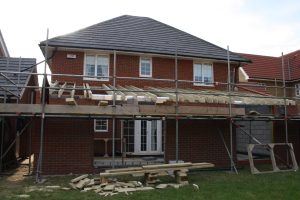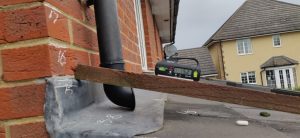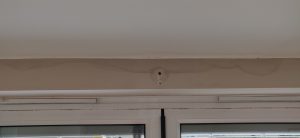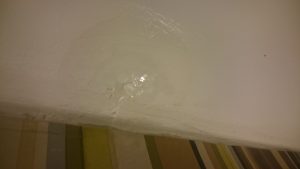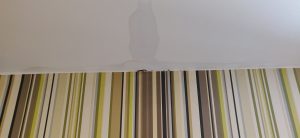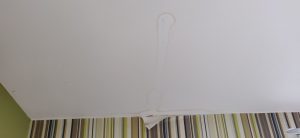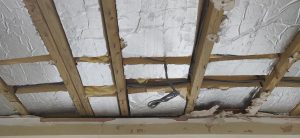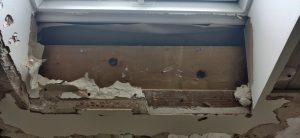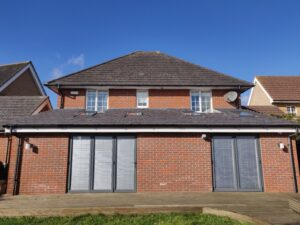Our Leaky Roof
In 2010 we contracted Aaron Cooper to build an extension to our home – although the build really did not go very well and we ended up having a disastrous time dealing with a leaky home. At the time he was trading under Crowne Homes Ltd, but he put this company into voluntary liquidation in December 2020 (being finally dissolved in April 223) – leaving us to pick up the pieces of our failed roof. By this point, we had spent many years going back and forth trying to get him to rectify the works he had undertaken – and his walking away was the final nail in a very painful and stressful experience. What made things worse was that at the time he walked away from us, Mr Cooper was then busily trading under Longmeadow (Suffolk) Ltd (which he incorporated in March 2019). But like Crowne Homes Ltd, that was also subsequently put into voluntary liquidation (in April 2024). Read on for the details…
We had employed Mr Cooper as he was, and still is, listed as an architect (e.g., Companies House). We had not undertaken any development like this before, and believed as a qualified architect, he would deliver a good outcome for us. He later informed us that he is not actually an architect (he stated he is an architectural technician). But that was too late, as by then, the outcome was already not good (although arguably, the difference between one and the other is a moot point in terms of what went wrong).

TL;DR
This page summarises our journey of discovering, living with, and eventually getting fixed, a leaking extension roof, and subsequently finding out what had gone wrong.
The summary (Too Long: Didn’t Read) version is that the roof pitch was far too low for various materials used and the roof ended up leaking like a sieve. Building Control also had an outstanding query about the sufficiency / installation of the two lintels that had been used (which we only discovered 6 years after the build). Despite numerous promises to rectify the roof, which continued over a number of years, it was never fixed. When Crowne Homes Ltd was put into liquidation, it felt like they had simply washed their hands of us. We felt angry and betrayed. We had to contract another builder to remove and rebuild the whole roof (i.e., including all rafters etc.), which basically cost us all of our savings.
- Early warning signs
- It’s been done all wrong!
- It’s getting worse – not better!
- Left in the lurch!
- Some interesting discoveries
- Building Control
- So what happened to fix it?
- Who did we use?
Early warning signs
The back of house went from no extension – to extension over the Summer of 2010. The works came to end in the Autumn of 2010.
Between 2012 and 2014 we experienced a couple of things that we now wish we had managed differently.
- The first of these was an early sign of leaking (a small water stain) in 2012/2013. This was initially inspected but nothing could be found. We reported it when it happened again and were told that the roofer was being called back. However, the roofer apparently failed to respond and we were told legal proceedings were initiated against him. Our roof was not inspected again – and we should have pressed for that immediately.
- The second of these issues happened in 2014 while we were waiting for the legal issues with the original roofer to be sorted out. We received some advice from an independent roofing company, who had been sent by NHBC to resolve something on our main roof. They commented that our extension roof pitch was too low for the tiles (Marley Eternit Edgemere). We looked into this and confirmed they were right – the minimum pitch was 17.5º and the roof was nearer 14º (or less). We contacted Mr Cooper to find out how this had happened? This is the response we got:
“I can confirm that I am, and was fully aware of the below 15 degree roof pitch, my notes state that the roof is 14 degrees, this was the best pitch we could achieve with the parameters of your house, i.e. with the distance out of the new room, and the required lead upstand under the first floor windows.
For this reason, we have used a roofing membrane, that allows us to construct a roof down as low as 10 degrees, and have gone over and beyond their recommendations, and double layered the roofing membrane, in a break joint fashion. we have also increased the head lap of the roofing tiles, all of which are perfectly acceptable practices. I cannot confirm or deny but believe we mentioned the pitch and proposal at the time of build.
This has also all been confirmed and passed by the Building Control department at MSDC, who are the overriding body of control.”
When we look back we try to understand why we didn’t do more after receiving these responses? We thought there may be an issue – so why did we react the way we did? We think the main reason was that there were some serious health issues happening in the family – and we were very much distracted by that. There was ‘some’ logic to what was said, and that may have led to us feeling reassured by the explanation? However, we regret that now – particularly as we later found out that many aspects of it were at best, misleading, and at worst, simply not true. We should have looked into this more as there were other aspects of the roof build that the pitch affected. Again, we really should have pursued.

It’s been done all wrong!
Then the situation escalated in 2016. After a period where things seemed to settle down, we noticed a bit of water coming through one roof window and made arrangements to have that looked at. This had happened once before (very early on) but we weren’t sure if we had left it ajar? Because of other things that were going on we were reluctantly getting paperwork together in case we needed to move. We found that we needed a Completion Certificate for the extension and didn’t have one, so we contacted Building Control to obtain a copy of it. In the ensuing period, we discovered:
- Building Control’s last visit was July 2010 (e.g., probably mid-way through the build). The Completion Inspection was never undertaken – and therefore the works had not been ‘passed’ by MSDC Building Control.
- In fact, Building Control had some serious concerns about the lintels that had been fitted. During the build, information was requested to confirm the suitability of lintels (it seems both because of the ones used and the way they had been installed). Six years later, that information had not yet been provided.
- The roof pitch was between 13.4º and 13.8º
- the roof tiles needed 17.5º (as we’d discovered earlier).
- the pitch was also too shallow for the Fakro roof windows – which needed 15º. Different flashing kits can be used to change the pitch of the windows – and Fakro Technical advised they would not have approved the use of the installed flashing kits for our roof, and that they could not (meaning they were not allowed to) recommend any of their special riser kits for our roof, as the Marley Eternit Edgemere tiles were fitted below their minimum specification.
- The “roofing membrane” referred to in 2014 was Dupont Tyvek Supro, which has an approved ‘below pitch application’. At the time, this allowed a tile with a minimum pitch of between 12º and 19º to be installed -2º lower than their normal minimum pitch and would allow a roof to be constructed at 10º (as was claimed by Mr Cooper) if the roof tiles could go down to 12º – and only if double layered. Mr Cooper referred to ‘Tyvek’ in the planning application and later stated “…your roof is fitted with Tyvek Dupont Supra [sic], in two layers laid break joint. This is still recognized as a low pitch roofing membrane that will allow the above tile [Marley Eternit Edgemere] to work at a lower pitch in this case approx 14 degrees.”. This was incorrect as the minimum pitch this membrane would allow our roof tiles to be installed was 15.5º! Dupont Technical confirmed the membrane had been fitted outside of their recommended limits (and that they would never have approved its use on our roof in 2010). However, this is all kind’ve irrelevant – see Battens and membrane below.
The following illustrates the pitch for the tiles (left – 17.5º) and the roof windows (right – 15º) against the pitch of the roof.

It’s getting worse – not better!
Over the following years we desperately tried to get the roof sorted out. Despite many emails (approx: 200 – 300 in total: which sometimes looked like something was going to happen), and various options being researched and proposed, nothing ever actually happened. We were reassured many times that the roof would be fixed, both by email and in person (including a meeting at the property to discuss and agree a plan for the remedial works). We looked at different roofing systems or solutions (such as Ondutile, EPDM, different primary tiles, and eventually using firrings to raise the pitch alongside inverted dormers around the windows). The majority of the substantive research was undertaken by us, and any drawings that were submitted to Building Control for their consideration were basically prepared by us (or were usually based on ones we had prepared). Most of these received approval. The works just never took place. This was enormously stressful – and really damaging for our health.
Regarding the insufficient lintels, we were told a Chartered Structural Engineer had been contracted to calculate if the installed lintels were alright – but nothing ever seemed to come of that? Later on, advice was also sought from ‘possible’ manufacturers (as it was unclear exactly which manufacturer had supplied the lintels!). Whilst a manufacturer was finally identified, they confirmed that the lintels had not been installed correctly. Consequently, they advised that their engineer was unable to assess the loads on the lintels, as they had not been installed in accordance with their guidance. They advised that any calculations they supply are based on the correct installation of their product. For quite a while, we weren’t even sure if they were the right ones?
During the time we were playing ’email ping pong’, the roof leaked, and leaked, and leaked. The health issues we were experiencing in 2014 were still very much present. Indeed, it was the sort of condition that was brought on, and exacerbated by stress – so that was something we didn’t need – but it was something we got plenty of!
In the early days – we had various patches appearing on the ceiling and walls.
As time went on, the windows leaked more and more.
And the water ingress / staining became worse – both in our Family Room
And in our Kitchen – which included a particularly upsetting flood one Christmas.

Left in the lurch!
After years of promises and reassurance that the roof would be fixed, and effort (mostly on our part) to achieve a solution, Crowne Homes Ltd was put into liquidation in December 2020 – we were notified in January 2021. We knew that Mr Cooper was (and still is) actively trading under Longmeadow (Suffolk) Ltd (which is another building development company – indeed both companies have the same Contracts Manager [Greg Rowe] – what a coincidence?). We very much felt that we had been strung along and then left in the lurch – events that transpired after this reinforced this.
Why did we feel strung along?
- December 2012 – April 2014: Some early signs were not resolved – and we regret not pursuing them (lesson here people – first sign of trouble – go hard and don’t give up!).
- November 2016 – January 2021: Years of leaks, stress and distress (impacting on our physical and mental health). Numerous options being researched and put together by ‘laymen’ – and no material resolution being actioned by the ‘professional’.
- January 2021: Advised that Crowne Homes Ltd in liquidation.
- January 2021 – November 2021: found another builder, agreed a solution, waited for them to be available, completed refit and decoration. This time period included the delays that were experienced waiting for some materials to arrive / be available because of a national shortage due to COVID, and general issues that cropped up during the build.
- January 2021: started preliminary discussions with new builder
- April 2021: roof rebuild not really thought an issue – addressing the lintels needing additional consideration and work
- June 2021: a (real) architect undertook a site visit and agreed a solution – proposal submitted to Building Control (accepted). NB: the look of this proposal was materially no different to previous solutions.
- ææ Waiting for builder to complete existing jobs ææ
- August 2021: job booked
- September 2021: scaffolding up
- October 2021: build complete
- November 2021: redecorating complete
It took another builder months to achieve what Crowne Homes Ltd never could – to put right the mess that Crowne Homes Ltd created. And that was another builder (and their team – architect, roofer etc.) who did the preparation, arrangements, and work – it was not done by me / us! If it was that easy, why couldn’t Crowne Homes Ltd / Aaron Cooper do it? The principle difference here is that we paid for this – because Crowne Homes Ltd left us in the lurch. But as we noted to them – whilst it may be convenient (and legally accurate) to say ‘Crowne Homes Ltd’ built our extension – it didn’t – human beings did – Aaron Cooper did. And along these lines, that is why it simply feels Aaron Cooper left us in the lurch.

Some interesting discoveries
During the build we had to completely remove the old roof, and replace it with one that was watertight and compliant with Building Regulations (and within the tolerances set by the material manufacturers). We were intrigued (and appalled) by some of the things that we found.
Rafter birdsmouth notch
On the original roof, 200 x 47 rafters were used – when we rebuilt – 225 x 47 rafters were used. I believe it was decided to use the larger rafter to ensure good ventilation. However, we didn’t expect to find such an aggressive birdsmouth notch cut into the original rafters. The 200 x 47 rafters were closer to 190mm. There was 75mm of rafter left after the cut – meaning that 115mm had been removed. The general rule of thumb (and requirement by some Building Control Officers) is that the notch should be no more than one third (e.g. 33.33%) of the depth – here up to 60.5% of the rafter had been removed!
Battens and membrane
With the amount of water ingress we’d experienced, we weren’t surprised to see that some of the tile battens were totally rotten through – although it was an illustration of how bad a state the roof had got in. What did surprise us was the membrane we found underneath!
The issue with the membrane was that there were two different types, 1) Permavent Breather Membrane and 2) Glidevale Protect VP400, and that neither of these were Dupont Tyvek Supro! A lot had been said about using a particular membrane that allowed the roof to be pitched “…as low as 10 degrees…”. Whilst Dupont has a ‘below pitch application‘ specification (which has been updated to allow -3º under the tile’s minimum pitch), there doesn’t seem to be any reference to ‘below’ or ‘low’ pitch applications for the Permavent or Protect VP400 membranes (indeed, their technical departments have confirmed there isn’t).
So basically, Crowne Homes Ltd specified ‘Tyvek’ in the planning application documentation (including using it where the roof is “…below the minimum pitch for the tiles…”), consistently referred to this product over the years, and claimed to be relying upon this particular membrane’s ‘below pitch application’, when they didn’t even use it?
Ventilation, ventilation, ventilation!
One of the things that our later Building Control Officers were pretty specific about was the need for ventilation. Unsurprising really, as this is a very clear requirement in the Building Regulations. So we were therefore somewhat confused when we realised that this hadn’t been provided in our original extension roof? The baseline seems to be that there should be a 25mm opening at the eaves AND a 25mm opening at the abutment to the house wall (both because the roof was under 15º and the ceiling followed the slope of the roof). Whilst Dupont advise Tyvek Supro can be installed without this ventilation – as Tyvek Supro wasn’t actually used, this doesn’t apply. Mixing the Permavent and VP400 membranes complicates things a bit. Each product has different specifications and guidance, and the performance of each one is likely to be affected by the double layering with a completely different membrane system? Unless a manufacturer says their membrane can be double layered (like Tyvek Supro), it is generally understood (and advised) that double layering will adversely affect the breathability of the membrane – and as such – increase the need for ventilation.
Out of interest, we investigated this a bit. At the time of the build, BS5250: 2002 was in effect. A 50mm ‘continuous air gap’ was specified in the Building Construction Notes submitted by Mr Cooper to Building Control. Under BS5250, this seems to fit a Pitched roof — Small ventilated void above insulation and a type HR underlay. The only problem with this was that there was nowhere for that air to go? (i.e., there should have been ventilation at low and high levels – but there wasn’t a high level opening). It seems that for a Pitched roof — Small ventilated void above insulation and a type HR underlay, BS5250 also required a Vapour Control Layer (VCL) under the insulation. Unfortunately, we also didn’t have that.
But, we thought, technically these membranes are LR not HR systems, so that would suggest it was a Pitched roof — Small void above insulation and a type LR underlay roof design? However, that apparently would have still needed an effective VCL – and because we didn’t have one – BS5250 required low and high level ventilation (that’s right, we didn’t have that). The membrane manufacturers basically explained the same thing – e.g., with our tiles. we would need ventilation unless we had a well sealed ceiling, which…
“…is usually achieved by lining the ceiling with an air tight membrane and taping the perimeter to ensure water vapour cannot enter the space where the insulation is situated.”
Glidevale Technical Department
You can see from the pictures of the original roof that there was no high level ventilation, with the lead detail being dressed straight onto the tiles (and no other high level ventilation solutions were used).
Lovely insulation
We found some wonderful gaps in our Celotex insulation when taking the old roof down. In the main, this seemed to be where the wiring had been run for the three pendent lights we have – although we also discovered a complete (and unused) wiring circuit for several spot lights that were never part of the original build specification? There were also some fabulous gaps in our insulation at the reveals for our roof windows. Nice! (in case you’re wondering, our new builder ran the same lighting circuit during the rebuild without needing to cut the Celotex at all).

Building Control
A few words about our local Building Control.
Over the course of this experience, we had three Building Control Officers (BCO). The first was the BCO who supervised the build. Something that has never been understood is why / how that BCO allowed this all to happen? It is alleged he signed off on all of this (we say it like that as we have no record of this ourselves). The major issues are the use of materials outside of manufacturers specifications / limitations, and this is the reason the roof and windows have failed.
The second BCO picked up the issues we were facing and advised what was needed to bring the build into compliance with regulations. What was striking is from his involvement to the end, the BCO expectation was that the solutions were either clearly within manufacturer specifications or had been signed off by the manufacturer. After the second BCO left our local Building Control service, we were lucky enough to be picked up by the BCO Manager, and he has been great in helping achieve a solution.

So what happened to fix it?
As indicated, we had to remove all of the old roof and had a completely new roof built.
- The plan was to use new rafters to adjust the pitch and work around the first floor windows using inverted dormers – that did happen (we’re glad we didn’t reuse the existing rafters and add on firrings – given the state of those birdsmouth notches!)
- But the plan also was to reuse the existing tiles and roof windows – that didn’t happen!
- We couldn’t reuse the existing tiles as about one third simply disintegrated as they were being removed (frost damage etc. from the low pitch). We had to order new tiles to replace the old ones – at a time when (concrete) roof tiles were experiencing a shortage. Great! But it was sorted.
- We also ‘had issues’ with the flashing specifications for our Fakro roof windows – and some water ingress when it probably shouldn’t have happened? In the end, we bit the bullet and ordered Velux replacements. I can honestly say that by being able to compare the two window systems, Velux are far superior to Fakro – by a good country mile!
- Even though the pitch of the roof was raised, we used a specialist HR membrane (that can be used down to 12.5º with interlocking tiles such as ours).
- The installation of the lintels was assessed and reinforced to the satisfaction of Building Control.
- We did have proper abutment ventilation added when we rebuilt the roof!

Who did we use?
To put all of this right we used Matt Sears Carpentry & Building – you can also find them on Checkatrade. They were fantastic! Matt really understood the stress and turmoil that we had gone through and ensured that we ended up with a solution that balanced what we were hoping for in terms of aesthetics with a watertight, fully compliant roofing system.






